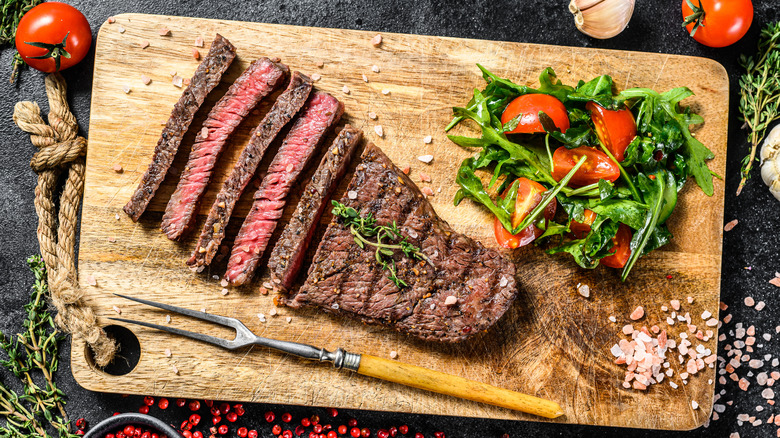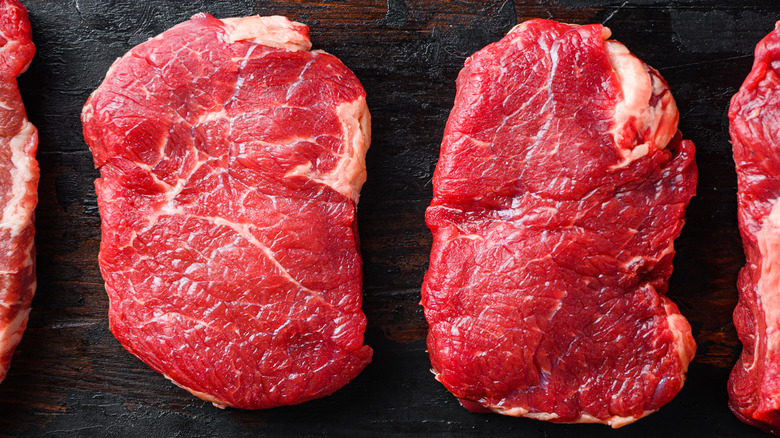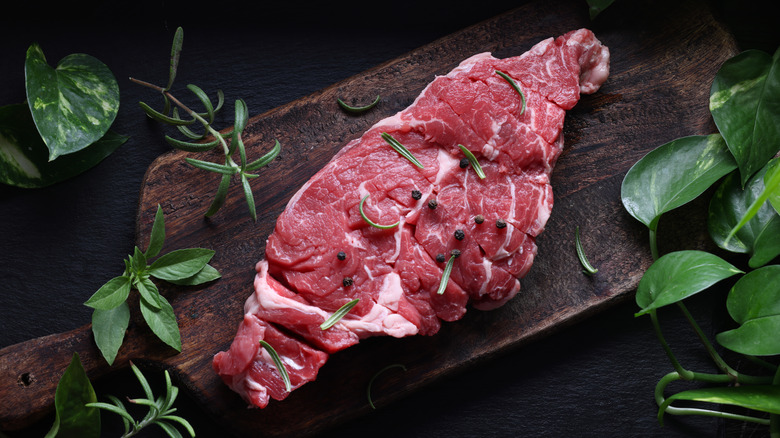The Affordable Ribeye Swap For A Leaner Steak Night
People have hot opinions about steak. It would be impossible to tally all the internet debates over the best cooking method and the right degree of doneness, but one thing steak aficionados tend to agree on is that ribeye steaks are delicious. Ribeye frequently tops rankings of the best cuts of steak thanks to its generous marbling. That refers to intramuscular fat, the thin white veins you'll see through a ribeye, which contribute to both flavor and tenderness. As beloved as it is, however, ribeye has a major drawback: It's expensive as all get out.
According to the market research platform IndexBox, the average for a USDA Choice ribeye steak is $13.99 per pound. That's a pretty penny, and Choice isn't even the highest of the beef cut grades. A USDA Prime ribeye steak averages a whopping $17.99 per pound. If you're looking for a more affordable alternative, there are a few options to choose from, but the most underrated is probably rump steak. Some people might balk at the idea of exchanging rump steak for ribeye, given the fact that rump steak is a significantly leaner cut, but with the right cooking technique, you can easily pull off this swap and get an extremely flavorful steak for a fraction of the price.
What is rump steak?
As you can probably guess, rump steak comes from the cow's hindquarters. It is also known as round steak because, let's face it, asking the butcher to give you a rump can be a little bit awkward. It is important to note that, in many other countries, "rump steak" refers to what Americans call a sirloin steak, and even though they are different, they are very closely related. The rump/round of a cow is located immediately behind the sirloin at the base of the cow's spine. Both cuts may be offered as roasts, or cut into individual steaks.
The rump is composed of multiple muscle groups, and since it is located at the cow's hind legs, these muscles do a lot of work. Consequently, rump steaks are much leaner than ribeye steaks, which see very little action since they come from the cow's rib section. Rump steak is, therefore, a great option for adherents of the paleo diet and anyone who prefers lean meat in general. It's also about half the price of a ribeye, with The U.S. Bureau of Labor Statistics reporting that round/rump steaks average just under $8 per pound.
Rump steak is prized for its intensely beefy flavor. Its one drawback is that lean meat can be terribly tough when it's cooked. Fortunately, there are a couple of kitchen tricks you can pull out to make it much more tender.
How to turn rump steak into a tender ribeye alternative
Rump steak isn't exactly a one-to-one substitute for ribeye. Since ribeye is so fatty, all you need to do is season it with salt and throw it on the grill for a delicious, tender, and juicy steak, but if you do the same for rump steak, it will almost certainly come out tough as leather. The solution to this problem is simple: Tenderize the rump steak before you cook it.
There are a few methods you can use to tenderize meat. The simplest and quickest is to beat the steak with the pointy side of a meat mallet to break up some of the tougher muscle fibers and connective tissue. You can even find rump steak at the grocery store that has already been tenderized this way under the name "cube steak," which refers to the square indentations left by the mallet.
Even better, you could tenderize rump steak with a marinade or dry brine, which also intensifies the flavor. If you make a marinade, make sure to add an acidic ingredient like citrus juice or wine, which will help to break down muscle fibers and connective tissue, and let the steak marinate for a few hours before cooking. Dry brining is even simpler — it's really just a fancy term for salting meat. Adding a generous sprinkling of salt to all sides of the steak and then letting it rest for an hour will help it retain its juices when you cook it.


